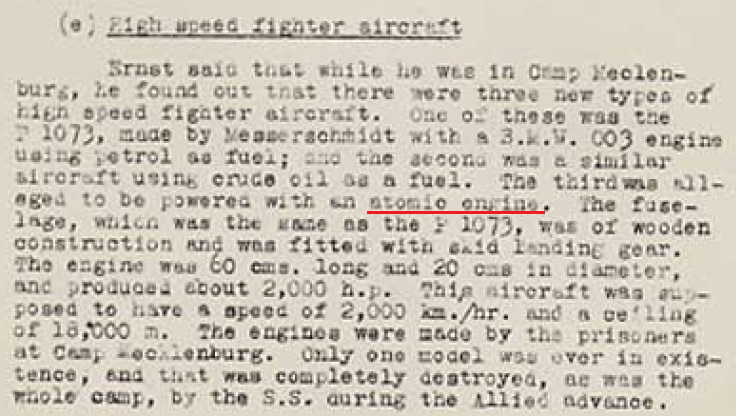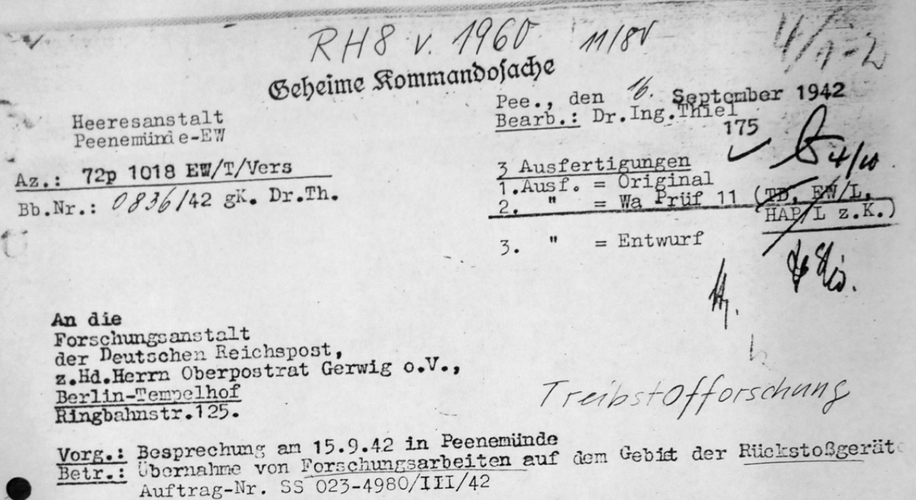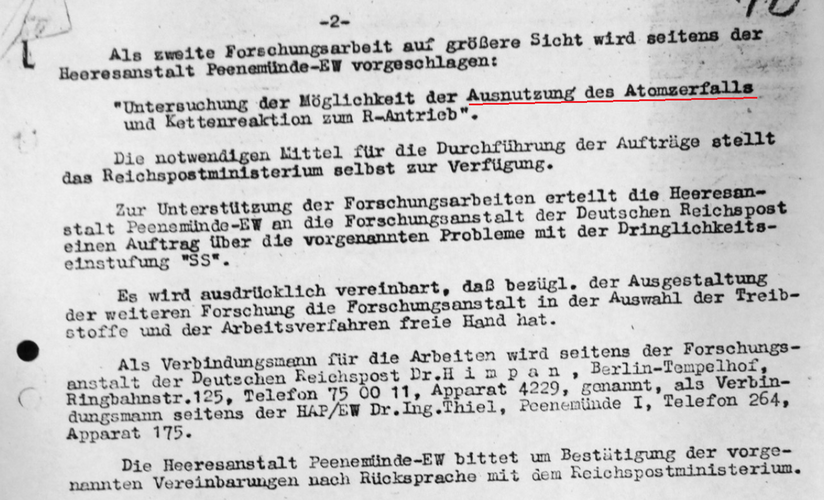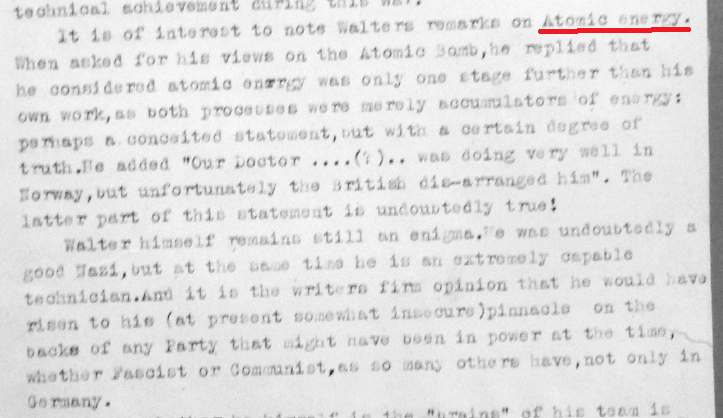Soviet GRU intelligence reports as follows:
General Ivan Ilyichev. 15 November 1944. Intelligence report to General Antonov and Joseph Stalin. Archive of the President of the Russian Federation, 93-81 (45) 37.
Peoples’ Commissariat of Defense of the USSR
Chief Intelligence Department of the Red Army
15 November 1944 Moscow
To the Head of the Red Army General HQ General of the Army, Comrade Antonov
Report:
Our trustworthy source in Germany reports: “The Germans are preparing to conduct tests of a new secret weapon, which has a large destructive power. The test explosion of a bomb of unusual construction is being prepared under highest secrecy in Thuringia. For the preparations of the tests the local residents are supposed to be transported away by an SS detail; the whole operation is reported to be undertaken in strictest secrecy. The explosions are supposed to take place in a wooded area. For that, special roads to the presumptive test site are being created. The bomb to be tested has a diameter of one and a half meters. It consists of several hollow spheres that nest inside each other. It will be brought to the explosion place with a transporter specially constructed for it. It is still unclear when the test is supposed to take place, but the preparations are going at the maximum fastest pace.
CONCLUSION. In the last months our source has reported more and more often about the feverish efforts of the Germans to test ever more powerful weapons and their means of delivery. Probably these experiments lead directly to an attempt of the Germans to actually carry out tests of atom bombs, about whose existence we have only incomplete, scanty information.”
Head of Chief Intelligence Department of the Red Army Lieutenant General Ilyichev
Typed 4 copies
Copy Nr. 1 — Comrade Stalin Nr. 2 — Comrade Molotov Nr. 3 — Comrade Antonov Nr. 4 — into archive
General Ivan Ilyichev. 23 March 1945. Intelligence report to General Antonov and Joseph Stalin. Archive of the President of the Russian Federation, 93-81 (45) 37.
Peoples’ Commissariat of Defense of the USSR
Chief Intelligence Department of the Red Army
[2]3 March 1945
Moscow
To the Head of the Red Army General HQ
General of the Army, Comrade Antonov
Report:
Our trustworthy source from Germany reports:
“The Germans have in recent times carried out two large-capacity bomb explosions in Thuringia. The explosions took place in a forest area, under conditions of strictest secrecy. Trees fell at a distance of 500–600 meters from the center of the explosion. Buildings and fortifications specially constructed for the tests have been destroyed.
Prisoners of war who were near the epicenter of the explosion died, often without leaving a trace. Prisoners of war who were in the area beyond the center of the explosion have burns on their face and body, the strength of which depends on their position in relation to the epicenter of the explosion. The tests were carried out in a remote deserted area. The regime of secrecy at the test site was at maximum level. Entrance and exit from the territory are by special pass only. SS soldiers have surrounded the area of tests and interrogated any person approaching the area.
The bomb, supposedly filled with uranium 235 and weighing approximately two tons, was brought to the test site on a specially constructed truck. Dewars of liquid oxygen were delivered together with it. The bomb was permanently guarded by 20 guards with dogs. The bomb explosion was accompanied by a large explosive wave and high temperature. In addition, a massive radioactive effect was observed. The bomb is a sphere with a diameter of 130 cm.
The bomb consists of:
1. High-voltage discharge tube, which is charged by special generators
2. A sphere made of metal uranium 235
3. A delay mechanism
4. Protective casing
5. Explosive substance
6. Detonating mechanism
7. Steel casing
All parts of the bomb fit inside each other.
Initiator or bomb fuse.
Consists of a special tube, which creates fast neutrons. It is charged by special generators, which create high voltage inside the tube. As a result, fast neutrons attack active material.
Active bomb material.
Active bomb material is uranium 235. It represents a sphere with an opening into which an initiator is inserted. Once this is done, the opening is sealed by a cork made of uranium 235.
Protective casing.
The uranium sphere is encased in a protective aluminum casing, which is covered by a layer of cadmium. This significantly slows down thermal neutrons emanating from uranium 235, which can cause premature detonation.
Explosive matter.
After the layer of cadmium it is placed inside explosives that consist of porous TNT saturated with liquid oxygen; TNT is made up of bars of a specially chosen shape. The inner surface of the bars has a spherical curvature, which is the same as that of the external surface of the cadmium layer. Each of the bars is supplied with one detonator or two electrical fuses.
Casing.
TNT is covered by a protective layer made of a light aluminum alloy. A blasting mechanism is attached on top of this casing.
Exterior casing.
An exterior casing of armored steel is installed above the blasting mechanism.
Fairing.
A fairing made of a light alloy can be installed on top of the armored casing for future installation on a rocket of the V-type.
Bomb assembly.
The sphere, which consists of metal uranium, is placed inside a protective casing, which consists of aluminum, covered in a layer of cadmium, so that the opening in the sphere coinciding with the opening is sealed off by a uranium cork. After this the aluminum sphere, covered in cadmium, is sealed off by a cork, on top of which the last bar of TNT is placed. Next, liquid oxygen is pumped through the opening inside a protective casing, which covers the TNT. After this the bomb is ready for deployment.
Bomb ignition.
The bomb ignition is carried out with the help of a high-voltage discharge tube. It forms a flow of neutrons, which attack the active material. When the flow of neutrons impacts upon uranium, element 93 fissions, which speeds up the creation of a chain reaction Next, the detonating mechanism detonates the explosive matter, after which a shock from the explosion of the external layer of TNT mixed with liquid oxygen takes place, which is directed toward the center. This allows the uranium to reach a critical mass.
Ahead of this, before the explosion, the uranium sphere is irradiated with gamma-rays, the energy of which does not exceed 6 million electron volts, which many times increases its explosive qualities.
CONCLUSION.
Without doubt, the Germans are carrying out tests of a bomb of high destructive force. In the event of their successful conclusion and production of such bombs in sufficient quantities, they will have weapons capable of slowing down our advance.
Head of Chief Intelligence Department of the Red Army
Lieutenant General Ilyichev
Typed 4 copies
Copy Nr. 1 — Comrade Stalin
” Nr. 2 — Comrade Molotov
” Nr. 3 — Comrade Antonov
” Nr. 4 — into archive
16 pp.















